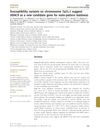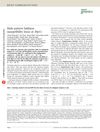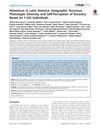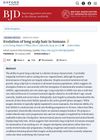TLDR Different human traits like skin color and hair type vary between populations due to genetic adaptations to the environment.
The 2017 document examines the genetic underpinnings of human phenotypic variation and its adaptation to different environments. It discusses how traits like skin color, hair morphology, and facial features differ between populations due to genetic adaptations to factors such as UV radiation and diet. The study of genome-wide SNP and sequence data helps identify traits under natural selection and genetic differentiation between populations. The document also explores adaptive evolution in the human genome and uses GWAS to understand the genetics of traits like height and obesity. It notes that while common variants explain some heritability, much is still unknown, necessitating further research into rare variants and epistatic effects. Specific genes are linked to adaptations in certain populations, such as the Inuit and Siberians, and to traits like pigmentation and hair morphology. Variations in genes like EDAR are associated with hair, teeth, and baldness, with different prevalences across ancestries. Additionally, the document covers earwax type, blood types, and secretor status, indicating that infectious diseases have been a significant selective pressure in human evolution. Understanding these phenotypic variations provides insights into human history and past environmental adaptations.
 87 citations
,
May 2012 in “PLOS Genetics”
87 citations
,
May 2012 in “PLOS Genetics” Six new genetic regions linked to early hair loss also connect to Parkinson's disease and prostate cancer, possibly leading to new treatments.
 51 citations
,
November 2011 in “British Journal of Dermatology”
51 citations
,
November 2011 in “British Journal of Dermatology” A gene called HDAC9 might be a new factor in male-pattern baldness.
 126 citations
,
January 2010 in “British Journal of Dermatology”
126 citations
,
January 2010 in “British Journal of Dermatology” Baldness is more common in Chinese men than women, increasing with age, and is influenced by genetics.
234 citations
,
November 2009 in “American journal of human genetics” Common variants in the Trichohyalin gene are linked to straight hair in Europeans.
 42 citations
,
April 2009 in “Human Genetics”
42 citations
,
April 2009 in “Human Genetics” A specific genetic mutation may increase male pattern baldness risk, especially in Europeans.
140 citations
,
October 2008 in “Nature Genetics”  111 citations
,
October 2008 in “Nature Genetics”
111 citations
,
October 2008 in “Nature Genetics” Researchers found a new gene area linked to male-pattern baldness, which, along with another gene, significantly increases the risk of hair loss in men.
299 citations
,
March 2001 in “Journal of Investigative Dermatology” Male pattern baldness is linked to specific genetic variations in the androgen receptor gene.
 340 citations
,
September 2014 in “PLOS Genetics”
340 citations
,
September 2014 in “PLOS Genetics” The study found that in Latin America, ancestry varies by location, influences physical traits, and affects how people perceive their own heritage.
 196 citations
,
March 2016 in “Nature Communications”
196 citations
,
March 2016 in “Nature Communications” Genetic factors influence hair traits like shape, color, and greying in Latin Americans.
 4 citations
,
December 2012 in “Human Biology”
4 citations
,
December 2012 in “Human Biology” The most different genetic segment between Africans and East Asians is the EDA2R/AR region, with two main types influenced by population changes and natural selection, and linked to baldness.
 January 2025 in “British Journal of Dermatology”
January 2025 in “British Journal of Dermatology” Long scalp hair evolved for cooling and social signaling.
5 citations
,
December 2011 in “Springer eBooks”









